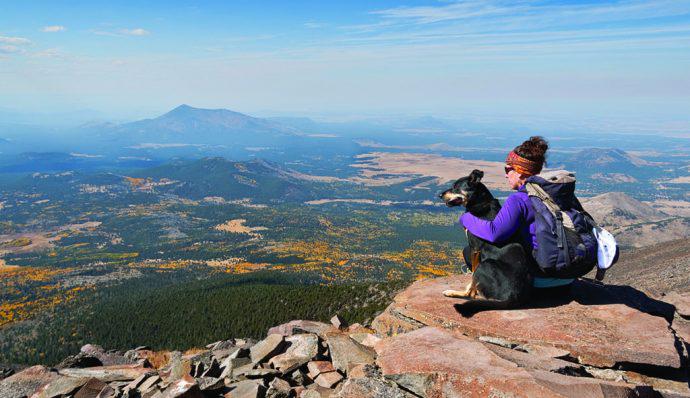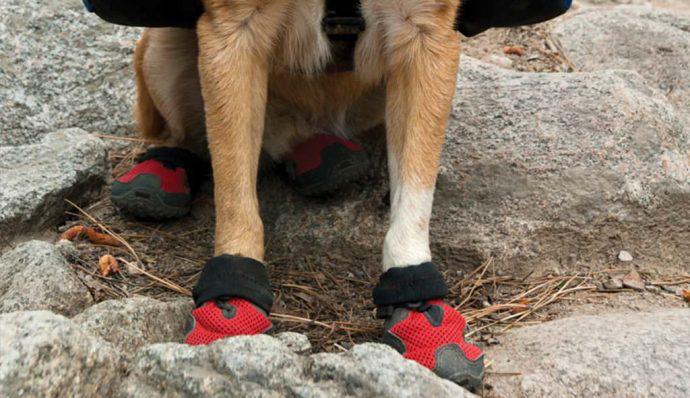Bringing your dog along on a hike is one of the best parts of the adventure. In fact, it can be tough to determine who is more excited: you or your pup! Hiking or backpacking with a dog can be a lot of fun, but it is also important to handle your dog responsibly. My 11-year-old mutt, Tally, has been a solid adventure companion for the past decade, but our journey has not been without mistakes. Together, we’ve learned a lot of about dog gear, first aid for pups, wildlife experiences, and overall doggy boundaries. I’d like to save you the mistakes that Tally and I made together, so read on for more tips on how to safely enjoy hiking with a dog. 
Planning your trip
Before you set paw (or boot) to trail, there are a few factors to consider. First of all, it’s not a bad idea to evaluate Fido.
Is your dog physically fit?
Dogs are just like humans: some carry extra weight and some are rail-thin. And, just like you or me, some dogs are in much better shape than others! No, you don’t need to take your dog to Fido Bootcamp every Saturday to prep him for your upcoming hike. But, you do need to regularly get your dog active to ensure he is ready to tackle a day of hiking. I’d suggest starting out with 30-60 minute hikes, depending on your dog’s physical abilities. Gradually add more time until your dog can comfortably tackle 6-8 hours of hiking without any problems. As your dog’s endurance builds, you will want to consider adding some weight. We’ll talk more about this in a bit, but a dog backpack can be a crucial piece of gear for your pup. That said, she has to be in good enough condition to carry the weight. Once your pup can handle the mileage, gradually ask her to start carrying a load on her back. Not only will these practice runs encourage physicality in your dog, but they will also prepare his paws for the rigors of hiking. Trails can be tough on pristine puppy paws, so regular hiking will toughen them up. Once they are more durable, they are less likely to rip on sharp stones or sticks.
Trail regulations
After your dog is in prime physical shape, it is time to consider where you will go hiking. Those of us who love dogs may struggle with this, but not all trails allow canines. For example, the hiking trails in national parks routinely do not allow dogs. Be sure to do your research ahead of time so you don’t show up at a trailhead only to learn your weekend plans are all for naught. Once you do find a dog-friendly trail, check out the regulations in regards to etiquette. In most places, your dog is required to be on a leash that is six feet or less. Very few places allow off-leash dogs, although there are some trails where this is allowed. These variations are why pre-hike research is important. Another factor to be aware of before hiking with your dog is the pup’s manners. Yes, I know this sounds weird; they are dogs! But appropriate dog manners on the trail are an integral component to any hike. When Tally and I first started hiking together, I quickly learned that she was protective of me, particularly when attached to a leash. As a result, she would try to jump on anyone that hiked by me too closely. Once I realized this, I began stepping off the trail to keep ample distance between Tally and any other hikers. Not only did this keep her from interrupting their hikes, but it also helped her realize that the world was not out to get her. Even if your trail allows for dogs to be off leash, it’s a good idea to play it safe and keep Fido leashed up until you learn the area. Wildlife can be a factor to consider, and no one knows how their dog will react to a bull moose until they are in the middle of the situation. Should you encounter a large animal, it will be helpful to have your dog under control via a leash. Not only will this defuse the situation, but it will potentially keep your dog safer and out of harm’s way. Finally, mind your manners and leave no trace while on the trail. It is inevitable: your dog will poop at some point during your hike. Don’t leave your pet’s waste on the trail, hoping that no one will notice. As the responsible pet owner, it is your duty to clean up after your dog.
What to pack
It takes a lot of practice to learn what you need to bring for a day of hiking or an overnight at camp. When you throw your pooch into the mix, there is a second set of gear that you need to account for. For all trips, don’t forget to include poop bags to clean up your dog’s waste on the trail.
First aid
First and foremost, don’t forget to pack your pup’s first aid kit. As human hikers, it is second nature to carry our own medical supplies, but your dog requires different items. Many companies make dog-specific first aid kits, so you can purchase one at any outdoor goods store. If you prefer, you can build your own a la carte. If you opt for the latter, be sure to include the following items in your kit:
- Gauze and heavy-duty bandages
- Saline wash in a bottle that squirts (in case of foreign debris, skunk spray, etc.)
- Antibiotic ointment and/or antiseptic wipes (to clean and disinfect wounds)
- Splinter remover/tick nipper (to remove ticks, splinters, quills, etc. from your pup’s body)
- Antihistamine like Benadryl (in case your dog has a bad reaction to a bite or sting)
- Pain reliever such as a buffered aspirin. Regular over-the-counter medications like Aleve, Advil or Tylenol can cause serious internal problems for your pup. When in doubt, ask your veterinarian for a canine-specific pain reliever.
- Tip: If you need to give your dog a pill, try to mix it in with your dog's food and hopefully she’ll gobble it up with her next meal. But, if you need her to take it at a specific time that doesn't match the dinner hour, I suggest: 1) Packing a small portion of cheese and wrapping the pill in the cheese. Usually it disguises the pill enough that your pooch will scarf it right up. 2) Sometimes, you don't have any snacks but it is important to get the pill down. Carefully open your dog's jaw and place the pill in the back of her throat, making sure it goes over the hump of her tongue. Then, gently hold her muzzle shut and aim her nose to the sky. Massage her throat in a downwards motion to help guide the pill down.
- Rubber gloves
- A muzzle (Even man’s best friend may snap at his beloved owner while enduring the pain of porcupine quill removal.)
Food and water
Just like humans, food and water are critical to a fun hiking adventure with your dog. Assuming your dog carries a pack, she can likely carry her own food and water supplies. In fact, some dog packs have built-in hydration systems with accompanying water bladders. How much food and water should you pack for your pooch? That varies depending on your dog, the intensity of the trip, and the location of the trail. If you know you are going to be hiking along water for most of the day, you can easily filter more to give to Fido. However, if you will be away from a water source, be sure to pack enough hydration for the both of you. Should you filter your dog’s water? As a rule of thumb, yes. Dogs are susceptible to giardia in particular, just like humans. To avoid any stomach distress, filter and/or treat your pup’s water just like your own. That said, I’ve come to realize Tally has a knack for knowing when water is or is not safe to drink. If a stream is truly questionable, she always seems to understand and turns her head in disgust. Trust your dog’s instincts, but err on the side of safety. Knowing how much food to bring for your canine companion can be a daunting task. At minimum, bring as much as she eats on a daily basis. Most dogs, however, will need more than that. You can experiment with the quantity of food or, if you are really unsure, check with your vet. He will be able to recommend an appropriate quantity for your trip. As more and more people go hiking with their dogs, the canine food market is catching up. It is absolutely acceptable to bring your dog’s regular food on a trip. After all, your dog knows and loves that variety already. But, if you know that you will be going backpacking for multiple nights, it may be worth considering other food options in order to cut weight. After all, five days of dog food can add up. Many dog brands are now making doggy energy bars. Packed full of the essential nutrients and calories, these bars are a condensed form of dog food that take up less space in a backpack. Tally has tried a few and particularly enjoyed the bacon flavor! A few others brands are now experimenting with dehydrated dog food. Just like with human backpacking food, the dehydrated dog kibble is easily packable and weighs next to nothing. This makes it easier to pack multiple days of food. The downside is that your dog needs to wait for the prescribed time for the food to rehydrate. If your pup is anything like Tally, the scent of the “cooking” food will drive him crazy in anticipation. Above all, don’t forget to bring food and water bowls for Fido. There are many hiking-specific bowls that weigh a few ounces and are collapsible, making them easy to pack.
Sleeping gear
Don’t forget to consider your dog’s sleeping options if you will be spending an evening on the trail. Where your dog sleeps is your decision. Many pet owners keep their pup in the tent vestibule while others allow Fido inside. That is your call. Regardless of where he sleeps, it is important to make sure your dog is warm enough during cold nights. I have one friend whose German Shorthaired Pointer regularly crawls inside her sleeping bag and nestles into the toe box to stay out of the cold. In fact, she has to unzip her bag from the bottom to allow Monty a “breathing hole” of fresh air. This works for her, largely because she is five feet tall and has the extra space in her sleeping bag. But for a larger human, these sleeping arrangements may pose a problem. To combat chilly temps, always bring some type of sleeping pad to get your dog off the ground. Some people bring an air pad (beware of sharp claws) while others opt for a half-length closed-cell foam pad. Regardless of your choice, this will be the first item that keeps your dog warm, thanks to the insulating properties of the pad. If colder temperatures warrant more than a sleeping pad, consider a sleeping bag. Some people opt for an ultralight two-person bag to allow their dog inside, while others pack a children’s sleeping bag. There is even one dog brand that makes a pup-specific sleeping bag. Consider all of your options, but remember that your dog’s safety and comfort are your responsibility.
Dog clothing
 The image of dog clothing can be a funny one, but it is also very real. You would be surprised at how many apparel items exist for pups! In particular, there are two categories of dog clothing to consider before taking your dog backpacking or hiking.
The image of dog clothing can be a funny one, but it is also very real. You would be surprised at how many apparel items exist for pups! In particular, there are two categories of dog clothing to consider before taking your dog backpacking or hiking.
Dog jackets or vests
Some dogs need additional insulation at their core in order to keep warm. In fact, if you know you will be hiking in snow or wet vegetation, it may be a good idea to pack a jacket for your dog. Specifically, pet jackets keep a dog’s underside warm. Short-haired dogs are more prone to the cold than longer-haired canines. On the flip side, you may consider a vest if hiking in extremely warm temperatures. Personally, this is something I have to consider with Tally far more than keeping her warm. She can sit in a snowbank for three days without becoming uncomfortable, but an hour of warm Colorado sunshine has her panting and sweating within minutes. Dog vests make great options for pups like her. You can dip the vest in a stream, ring it out, and put it back on her to help regulate her core temperature. There are even “solar vests” on the market that reflect the sun away from the dog’s fur.
Dog shoes
If you’ve never asked your dog to wear dog shoes, you are in for a real treat! Without fail, a pup’s first time in booties is a comical experience as she adjusts to the foreign items on her paws. Entertainment aside, dog booties can be a crucial piece of gear for your canine’s comfort and safety. Just like hiking boots protect our feet, the goal of dog shoes is to protect your pet’s paws from abrasions, tears and cuts. Many long-haired dogs require them in the winter to prevent their fur from gathering too much snow. Once this snow balls up and freezes, it creates sharp ice crystals that cut your dog’s sensitive pads. You will know this is happening when you see your dog’s paw prints leaving spots of blood in the snow. However, not all dogs experience this, so it is best to experiment with your pooch first. Many dogs struggle with rocky terrain in the summer. Sharp roots, sticks and boulders can tear up your dog’s feet, leaving their paws sore and uncomfortable. Tally and I learned the hard way after eight years of hiking together. We were returning from our 23rd 14er summit and I realized she had a severe limp. Upon investigation, I learned that she had ripped off a large portion of her paw’s pad. She was in so much pain that I finally opted to carry her 60-pound-body down the mountain myself. Obviously, the situation was less than ideal, but I learned my lesson: dog shoes. It may take some trial and error to find a pair of booties that your dog doesn’t hate and that don’t slip off her paws. But, once she adjusts to her new footwear, she will be grateful for the protection.
Dog packs
As we’ve discussed, your dog can help carry his gear in a dog pack. As a general rule, a dog can carry 15-25 percent of his weight. Of course, some canines are able to carry more while others should carry very little. Check with your vet if you have specific questions about your dog’s capabilities. In particular, you will need to fit your dog for the appropriately sized dog pack. For most dog packs, this will require you to measure the circumference of your dog’s chest. This is the measurement that most dog packs are sized from. Once your dog is wearing his pack, make sure it rests comfortably without squeezing his chest. You want the pack to stay in place without hindering your dog’s breathing. There are different types of dog packs, so be sure you purchase one that is specific to hiking and backpacking. These packs will carry more items and have additional padding to make for a more comfortable ride.
Water safety
If you and your pup will encounter navigable water features on your hike, it is important to consider Fido’s safety. In particular, a PFD may be a good idea.
Dog PFDs
PFDs (personal flotation devices) are a good choice for dogs like Tally. She has never been a water lover and gets spooked the second the water rises to her chest. If your dog is not a natural swimmer, grab him a PFD that is appropriate for your activity. Some offer more buoyancy for heavier dogs while others are lighter and merely a training tool. Identify what your dog needs to ensure a comfortable water experience. Just like with a dog pack, a PFD is fitted by the chest size of your canine companion. It should fit snugly so that it doesn’t slip off, without feeling too tight or uncomfortable. Many PFDs (and dog packs, too) have useful handles on the top. They make it easier for you to guide your dog across a river without him slipping away from you.
Additional gear
There are a few other niceties that may make hiking with your dog more enjoyable.
- Dog harnesses
- Collar Clip-on Lights (to find your dog in the dark)
- Pet wipes (to wipe down your dog’s fur after a particular dirty day on trail)
- Waist-belt leashes (to enjoy hands-free hiking)
In general, I’d suggest getting used to hiking with your dog before investing in expensive gear items. That way, you will better understand what equipment you need to add to your quiver without breaking the bank on unnecessary items.


